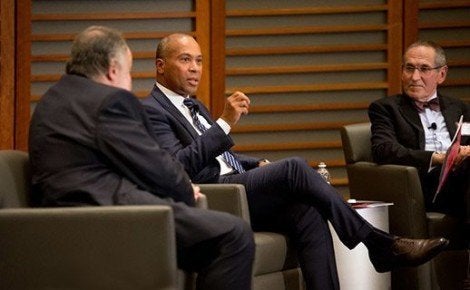November 12, 2015 – In the hours following the detonation of two bombs during the 2013 Boston Marathon, scores of people mobilized to tend to the injured and bring the perpetrators to justice. The response required agencies over multiple jurisdictions at the local, state, and national levels — who all had different lines of authority — to work together during a complex and ambiguous situation. No single person was “in charge.”
So why did it work? Researchers at Harvard T.H. Chan School of Public Health call it an example of “swarm intelligence.”
Experts at the School’s National Preparedness Leadership Initiative (NPLI) credit former Governor Deval Patrick with setting a tone that spread through the response team and the bystanders who pitched in to help. It was a belief that people who are empowered to do their best can accomplish more than any one leader can achieve separately.
Patrick joined NPLI Co-Director Leonard Marcus and NPLI faculty member Barry Dorn, both lecturers on public health practice, for a conversation on leadership during the Boston Marathon bombing response. The talk was the keynote for the annual meeting of the School’s Leadership Council, which was held October 28-29, 2015.
Listen to the full conversation.
Through studying the Marathon response, the NPLI researchers identified principles of swarm intelligence that can be applied to many difficult situations leaders face, not only in times of crisis but in everyday work life. Those five principles are:
- unity of mission;
- generosity of spirit and action;
- deference for the responsibility and authority of others;
- refraining from grabbing credit or hurling blame; and
- a foundation of trusting relationships.
With the crisis occurring toward the end of his second term in office, Patrick had built up relationships with many of the leaders he worked with during the response. But even with those he didn’t know, he trusted in their expertise, Patrick said.
Marcus observed that many elected officials panic in a crisis. This leads to a tendency to overstep into areas best handled by agency heads that report to them, and to micromanage. But Patrick approached the situation asking, “How can I be helpful?” Marcus said.
Although many whom NPLI interviewed for their case study on the response described Patrick’s calm demeanor during the crisis, he told the Harvard Chan audience, “I cannot overstate how much anxiety I had about whether we were at the end of the crisis or in the middle.” In the early hours following the bombings, no one knew if there was more to come. He described the difficult decision to ask that the people of Boston and surrounding communities “shelter in place” while law enforcement searched for the surviving perpetrator. That decision was made after a series of ultimately unrelated incidents were reported around the city early on the final morning of the crisis, leaving officials wondering if there was more to come.
This was another strength of Patrick’s handling of the situation, Marcus said — not living in the moment, but always anticipating the next moment.
But ultimately, the success of the Boston Marathon response was “not the success of official agencies alone. It was the success of an entire community acting like a community,” Marcus said.
Patrick agreed. The regular people who helped stranded or injured runners on the day of the marathon and brought food to law enforcement agents responded to a difficult situation with grace, he said. “Everyone brought their best.”
Photo: Emily Cuccarese
